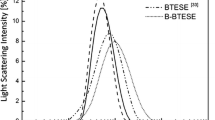Summary
Physical and gas transport properties of novel hyperbranched polyimide – silica hybrid membranes were investigated. Hyperbranched polyamic acid as a precursor was prepared by polycondensation of a triamine monomer, 1,3,5-tris(4-aminophenoxy)benzene (TAPOB), and a dianhydride monomer, 4,4’-(hexafluoro-isopropylidene)diphthalic anhydride (6FDA), and subsequently modified the end groups by 3-aminopropyltrimethoxysilane (APTrMOS). The hyperbranched polyimide – silica hybrid membranes were prepared using the polyamic acid, water, and tetramethoxysilane (TMOS) via a sol-gel technique. 5 % weight-loss temperature and glass transition temperature of the hyperbranched polyimide – silica hybrid membranes determined by TG-DTA measurement considerably increased with increasing silica content, indicating effective cross-linking at polymer – silica interface mediated by APTrMOS moiety. CO2, O2, and N2 permeability coefficients of the hybrid membranes increased with increasing silica content. It was pointed out that the increased gas permeabilities are mainly attributed to increase in the gas solubilities. On the contrary, CH4 permeability of the hybrid membranes decreased with increasing silica content because of decrease in the CH4 diffusivity and, as a result, CO2/CH4 selectivity of the hybrid membranes remarkably increased. It was concluded that the 6FDA-TAPOB hyperbranched polyimide – silica hybrid membranes have high thermal stability and excellent gas selectivity, and are expected to apply to a high-performance gas separation membrane.
Similar content being viewed by others
References
Sykes GF, Clair AKS (1986) J Appl Polym Sci 32:3725
Okamoto K, Tanaka K, Kita H, Ishida M, Kakimoto M, Imai Y (1992) Polym J 24:451
Langsman M, Burgoyne WF (1993) J Polym Sci A Polym Chem 31:909
Li Y, Wang X, Ding M, Xu J (1996) J Appl Polym Sci 61:741
Hirayama Y, Yoshinaga T, Kusuki Y, Ninomiya K, Sakakibara T, Tamari T (1996) J Membr Sci 111:169
Shimazu A, Miyazaki T, Maeda M, Ikeda K (2000) J Polym Sci B Polym Phys 38: 2525
Niwa M, Kawakami H, Kanamori T, Sinbo T, Kaito A, Nagaoka S (2001) Macromolecules 34:9039
Fang J, Kita H, Okamoto K (2000) Macromolecules 33:4639
Fang J, Kita H, Okamoto K (2001) J Membr Sci 182:245
Chen H, Yin J (2002) J Polym Sci A Polym Chem 40:3804
Suzuki T, Yamada Y (2004) Polymer in press
Joly C, Goizet S, Schrotter JC, Sanchez J, Escoubes M (1997) J Membr Sci 130:63
Cornelius CJ, Marand E (2002) J Membr Sci 202:97
Hibshman C, Cornelius CJ, Marand E (2003) J Membr Sci 211:25
Iwata M, Adachi T, Tomidokoro M, Ohta M, Kobayashi T (2002) J Appl Polym Sci 88:1752
Hibshman C, Mager M, Marand E (2004) J Membr Sci 229:73
Takeichi T, Stille JK (1986) Macromolecules 19:2093
Muruganandam N, Koros WJ, Paul DR (1987) J Polym Sci B Polym Phys 25:1999
Morisato A, Shen HC, Sankar SS, Freeman BD, Pinnau I, Casillas CG (1996) J Polym Sci B Polym Phys 34:2209
Pinnau I, Casillas CG, Morisato A, Freeman BD (1996) J Polym Sci B Polym Phys 34:2613
Dixon-Garrett SV, Nagai K, Freeman BD (2000) J Polym Sci B Polym Phys 38:1078
Weinkauf DH, Kim HD, Paul DR (1992) Macromolecules 25:788
Wu KH, Chang TC, Wang YT, Chiu YS (1999) J Polym Sci A Polym Chem 37:2275
Park HB, Kim JK, Nam SY, Lee YM (2003) J Membr Sci 220:59
Koros WJ, Fleming GK (1993) J Membr Sci 83:1
Freeman BD (1999) Macromolecules 32:375
Robeson LM (1991) J Membr Sci 62:165
Vu DQ, Koros WJ, Miller SJ (2003) J Membr Sci 211:311
Vu DQ, Koros WJ, Miller SJ (2003) J Membr Sci 211:335
He Z, Pinnau I, Morisato A (2004) Novel nanostructured polymer – inorganic hybrid membranes for vapor – gas separation. In: Pinnau I, Freeman BD (eds) Advanced materials for membrane separation. American Chemical Society, Washington, DC (ACS Symposium Series; 876, pp 218-233)
Author information
Authors and Affiliations
Corresponding author
Rights and permissions
About this article
Cite this article
Suzuki, T., Yamada, Y. Physical and Gas Transport Properties of Novel Hyperbranched Polyimide – Silica Hybrid Membranes. Polym. Bull. 53, 139–146 (2005). https://doi.org/10.1007/s00289-004-0322-9
Received:
Revised:
Accepted:
Published:
Issue Date:
DOI: https://doi.org/10.1007/s00289-004-0322-9




